Hello friends, are you planning to start commercial Date Palm Cultivation in Karnataka? Well, you are in the right place. The oldest cultivated tree fruit is the date palm, grown for its fruit. Dates, a kind of fruit, are both delicious and healthy. Middle Eastern countries and Africa primarily produce date palm plants, whereas Iran is the most significant exporter. Dry arid areas with irrigation systems are ideal for date palm cultivation. Let’s find out more information about the Dates cultivation in Karnataka below.
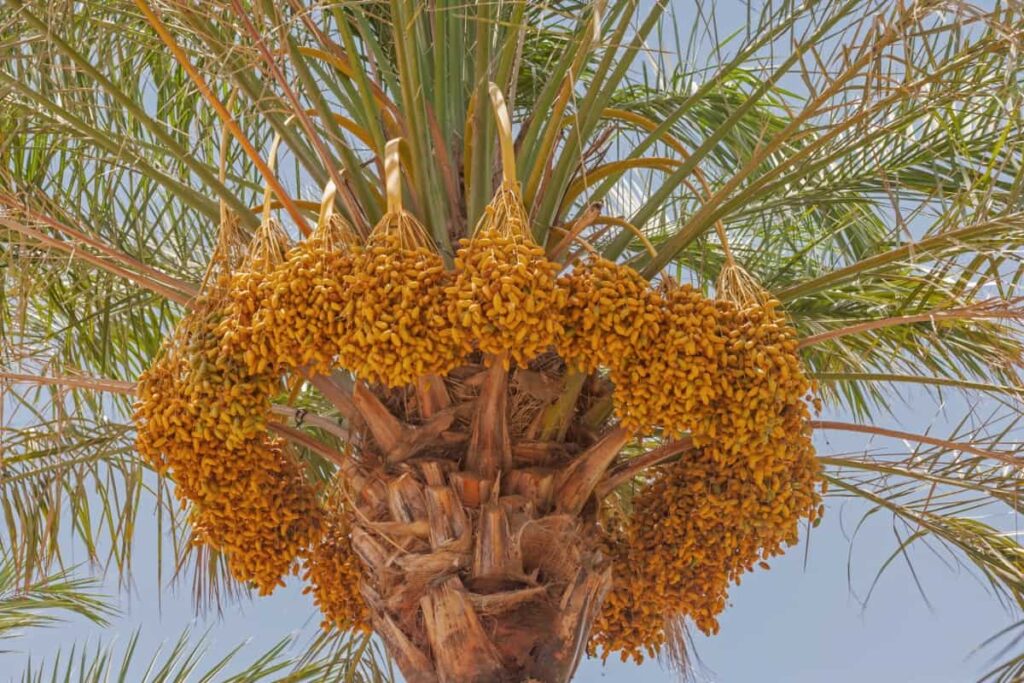
Dates cultivation in India is gaining momentum. Even the south Indian states such as Karnataka have been into it. In recent years after a few farmers successfully cultivated dates in a few districts of Karnataka, it is now proven that dates can be produced in Karnataka. Dates cultivation in Karnataka is growing every year and is not supported in all regions of Karnataka. However, only some districts of Karnataka support the cultivation of dates. Let us get into the details of Date Palm Cultivation in Karnataka.
Date Palm Cultivation in Karnataka
Climatic conditions of Karnataka supporting date palm farming
Agro-climatic conditions in the Karnataka districts of Kolar and Chikkaballapur are ideal for date palm farming since these areas can provide the required climatic conditions for the cultivation of the date. Dates need dry and hot temperatures to grow, and most of the regions in Karnataka support rain-fed crops. It’s hard to grow these trees in such soils and mild temperatures.
Date palms need a climate with plenty of sunshine and little rain. They cannot tolerate high humidity or rain. So when choosing an area in Karnataka state, make sure you consider these parameters, and also, you must select the sandy and loamy soils. As mentioned above, we can conclude from the experiences of previous date farmers that the Kolar and Chikkaballapur districts of Karnataka are ideal for date palm cultivation.
Commercial Date Palm Cultivation in Karnataka: A Step-By-Step Guide
Choose the Best Location
First and foremost, you’ll need to choose a suitable place for your date palm farm. As mentioned, a few districts like Kolar can support cultivating the date in Karnataka. While selecting a location, check certain factors such as exposure to direct sunlight and the soil’s fertility and drainage.
In case you missed it: Sustainable Agriculture Practices: Eco-Friendly, Healthy Farming Benefits and Ideas

Date palm trees can thrive in a wide range of soils and are tolerant to salinity in the area. The preferable and ideal soil pH for Date palm farming is between 8.0 and 11.0. It’s best to grow your plants on sandy loam soil that retains moisture, provides air circulation, and has a good drainage system. However, calcium carbonate-rich soils should be avoided while cultivating dates.
Ideal Climate Requirement to Grow Dates
Date farming thrives in climates with long, hot summers, high temperatures, and moderate winters without frost. Trees benefit from these circumstances for optimal development, flowering, and fruiting. However, these plants need a temperature of at least 20 degrees Celsius to live and thrive.
A temperature of around 35°C is necessary for pollination. Therefore, cold winters with no frost and very little rain are tolerable for date trees. On the other hand, flowering and fruit settings need low relative humidity, no rain, and high temperatures with warm nights. For date cultivation in Karnataka, there are certain places where you can achieve these factors.
In case you missed it: List of Agricultural Schemes in India: Every Farmer Must Know These

Date Palm Crop Season
Desert regions with irrigation systems are ideal for date palm cultivation. Date farming can thrive in locations with long, hot, dry summers, mild winters, and no rain during the ripening season of the fruit.
Date Seeds/Cuttings per Hectare
The exact quantity of seed required will vary depending on the type and planting technique. Perennial date palm trees have a life expectancy of at least 50 years, while it is possible for them to live longer. Date farming employs the square planting technique, with a distance between rows of 8 meters, to provide optimal intercultural activities and growth. There are around 160 plants per hectare of land in commercial date cultivation. Dates are a dioecious fruit. Thus, roughly 10% of these offshoots must be male to provide enough pollen grains.
How to Propagate Date Palms
A date palm’s seed, offshoots, and vegetative propagation can all be used to grow the plant. When the seed is used to propagate palms, it is impossible to tell whether the plants are male or female until they begin to flower. The finest variety of seeds is sown in plastic bags in the nursery. Farming in the monsoon season is ideal for planting seedlings in Karnataka. However, this is a time-consuming and labor-intensive technique of propagation.
Offshoot propagation involves separating the offshoots from the mother tree and transplanting them to the main area. Adult trees bear offshoots just once after their fourth or fifth year; younger trees often bear offshoots. A tree may produce two offspring in a year if soil conditions, irrigation, and fertilizer are properly maintained. Remove the older leaves with care to preserve the terminal bud.
Six months before separation, a combination of farmyard manure, sand, and dirt is placed at the branch’s base. A single cut should separate a branch and the mother tree at the union. You should treat the mother plant with a copper fungicide and then use IBA 1000 ppm on all offshoots and the rooting base. Offshoot propagation is highly recommended because it is simple and requires less effort, time, and money.
In case you missed it: Sustainable Greenhouse Farming: The Future of Agriculture
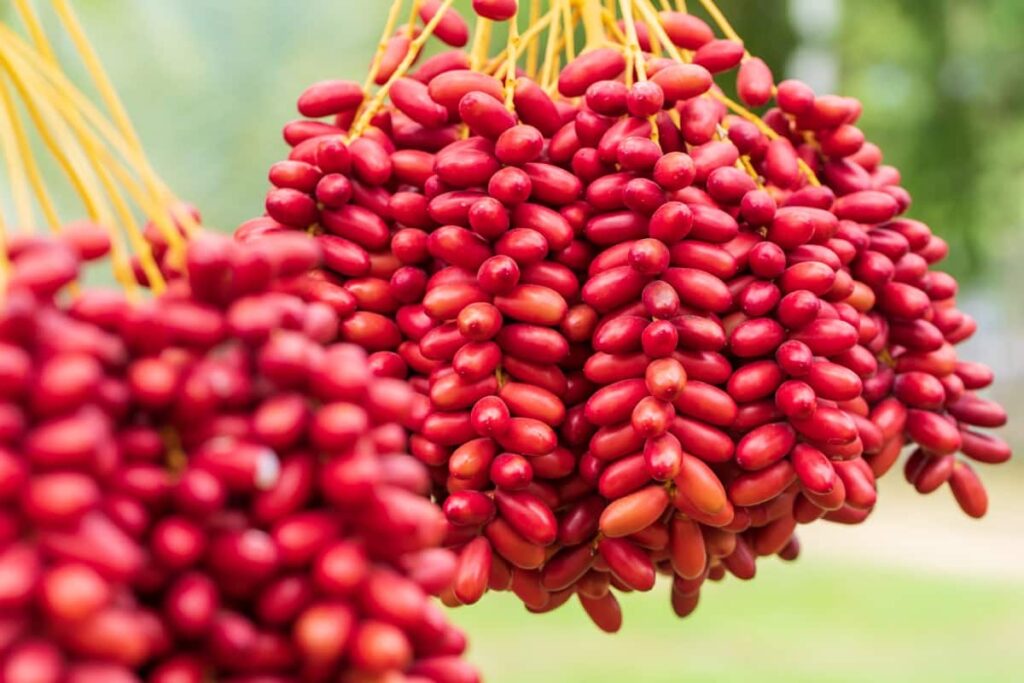
Date Palm Spacing While Planting
Seedlings with the finest fruiting female offshoots are transplanted to the main fields when they are old enough. First, 1 x 1 x 1 meter spaced pits are dug at a 7 x 7 meters to 10 x 10 meters spacing in the main field. Then, after two weeks in the sun, offshoots are planted from the pits. Mix 20 kg’s farmyard manure (FMY), 2 kg’s castor cake, sand, and sawdust into a well-mixed combination before applying it to each pit.
A five- to six-week period of daily watering is required for healthy root development before switching to alternate irrigation days for offshoots exposed to extremes of heat and cold. About 3% to 5% of the farm’s plants are male and placed at equal distances from the female plants. Pits should be spaced 8 m apart by 8 m apart, allowing for 156 trees per hectare. It will depend on your spacing if you wonder how many date trees per acre should be planted. However, the average is 60 to 65 data trees per acre.
Irrigation Required for Healthy Date Palm Growth
Even though the date palm can withstand periods of severe drought, it needs a large amount of water. Constant soil moisture is ideal, although it is sensitive to waterlogging. You need not water in the rainy season, and in heavy rain irrigation floods, water must be drained away since it might injure the planting.
If frequent irrigation is necessary after planting, 4 to 6 irrigations can be required yearly in places with high water tables. Water quality relies on the soil’s capacity to retain moisture and the local climate. Mulching is the most effective method of preventing weed development by retaining soil moisture. Irrigation rates can be reduced after the offshoots are set. Usually, these trees are drought tolerant; you do not need to water them in the rainy season.
Fruit Thinning and Regulating Leaf Numbers
Date palm plants are extensively pollinated because of their dioecious nature. Hand pollination is a common practice in commercial agriculture. Two to three male trees are needed for date cultivation for every 100 female date palms. Date palm trees’ male flowers should be intertwined with female flowers in a three-strand arrangement. In date palms, pollination is essential since pollen significantly impacts data quality and maturity time. Fruit thinning is critical in the early stages of farming and is best accomplished with chemical sprays.
The next year’s fruit thinning is necessary to ensure proper flowering and increase fruit quality. Premature fruit ripening is prevented as a result of this practice. Date palms need sufficient green leaves for healthy development and fruit production. Reducing the number of leaves might cause the fruit of lower quality. Depending on the variety, the ideal number of leaves ranges from 7 to 10 in the banshee variety to 8 to 9 in the Hallway variant. To encourage new leaf development, old leaves should be removed in June.
Date Palms Fertilizers
Applying organic and artificial fertilizers is essential for healthy plant development and a good harvest. Use as much organic fertilizer as possible on the field. And use 30:20:50 kg/ha of chemical N: P: K fertilizer. The recommended ‘N’ dose in India is 1.40 kg/tree. When it comes to yearly requirements, a mature tree needs 600 grams of “N” and 100 grams of “P” and “K” every year.
In case you missed it: How to Start Sustainable Sheep Farming: Benefits and How to Reduce Your Carbon Footprint with Sheep
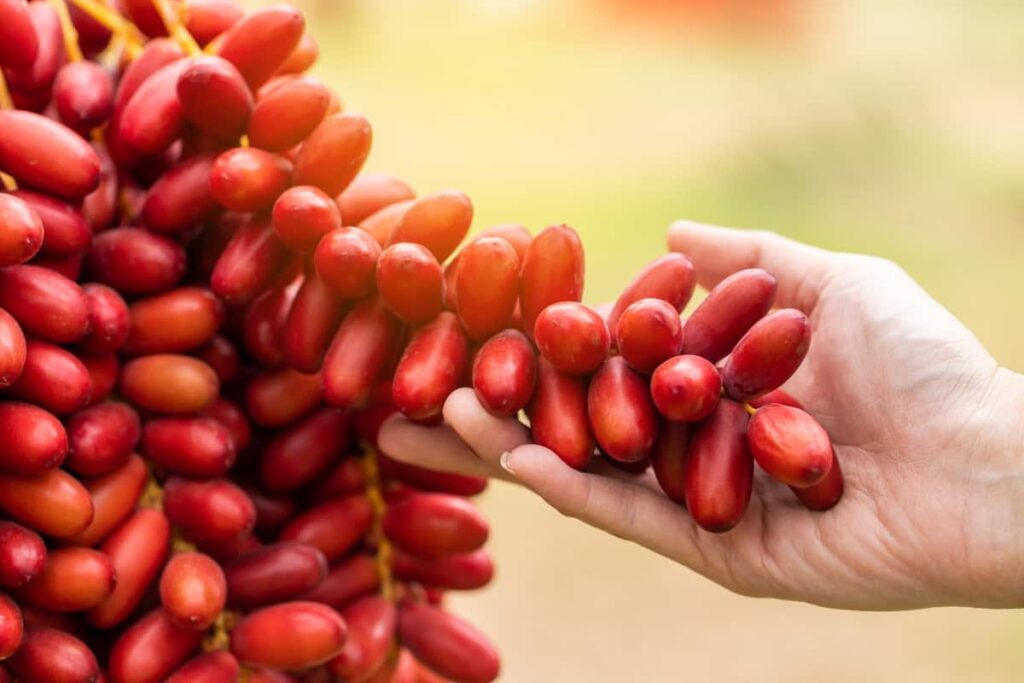
Pruning in Commercial Date Palm Cultivation
Pruning is a very important stage in Date palm cultivation; you have to prune them. Remove the sick and old leaves as soon as possible. This way, the farm’s appearance will be more vivid and healthy-looking. Pruning entails the removal of spines and inflorescences that are not desired. The number of leaves on the tree mainly determines the number of inflorescences a date palm tree can hold. Fruit development, quality, and maturation will be slowed if extra leaves are removed. This is how Date fruits are produced.
Pests and Diseases in Date Palm Cultivation in Karnataka
Pests of Date Palm
- Bou Faroua: ‘Goubar mites’ is another name for these mites. They may be found in any areas where date palms are grown. Mite larvae eat fruits, generating huge output losses. The mites deposit their eggs on the fruit stalks and the calyx area. The mites can be controlled by dusting the date brunches with 100-150 grams of sulfur per tree every day.
- Coconut rhinoceros beetle: Toxic to date, palm plants are the coconut rhinoceros beetle. Consult with a local specialist to get things under control.
- White scale: Adults and nymphs feed on the sap in many plants’ midribs, leaves, and fruits. Although the crop is not severely damaged, the fruits that have been infected are not marketable, which reduces the profits. Mineral oils can help you get rid of pests.
Diseases of Date Palm
- Bayoud: It is a fungal disease that affects offshoots, young plants, and even large trees near the base of their trunks. Soil treatment can be used to prevent this disease in its early stages. The most effective way of limiting the spread of disease is to remove and incinerate the diseased tree. Replanting is prevented by using methyl bromide or chloropicrin to treat the soil.
- Black scorch: The fungus that causes Black Scorch, or ‘Fool’s sickness,’ is to blame. Black scorch on the leaves, rotting of the trunk, inflorescence blight, and rotting of buds are symptoms of this disease. The first step in prevention is proper cleanliness, followed by cutting tree portions that have been impacted. Pruning cuttings should be treated with copper-based fungicides.
- Omphalia root rot: Decline disease is another name for Omphalia Root Rot. Premature frond death, growth slowdown, and eventual mortality are all symptoms of damaged date trees. Once every two weeks, provide four Brestan or Dexon spray doses to help manage this condition.
- Diplodia: Diplodia is a fungus-borne disease. Keep an eye on wounds or cuts caused by the Bordeaux mixture pruning.
- Khamedj: Fungus thrived in neglected plantations because of the warm, humid environment. Infected spathes must be removed and burned. If a palm has a Bordeaux combination disease, it must be treated.
In case you missed it: How to Start Sustainable Pig Farming: Business Plan, Benefits, and Requirements
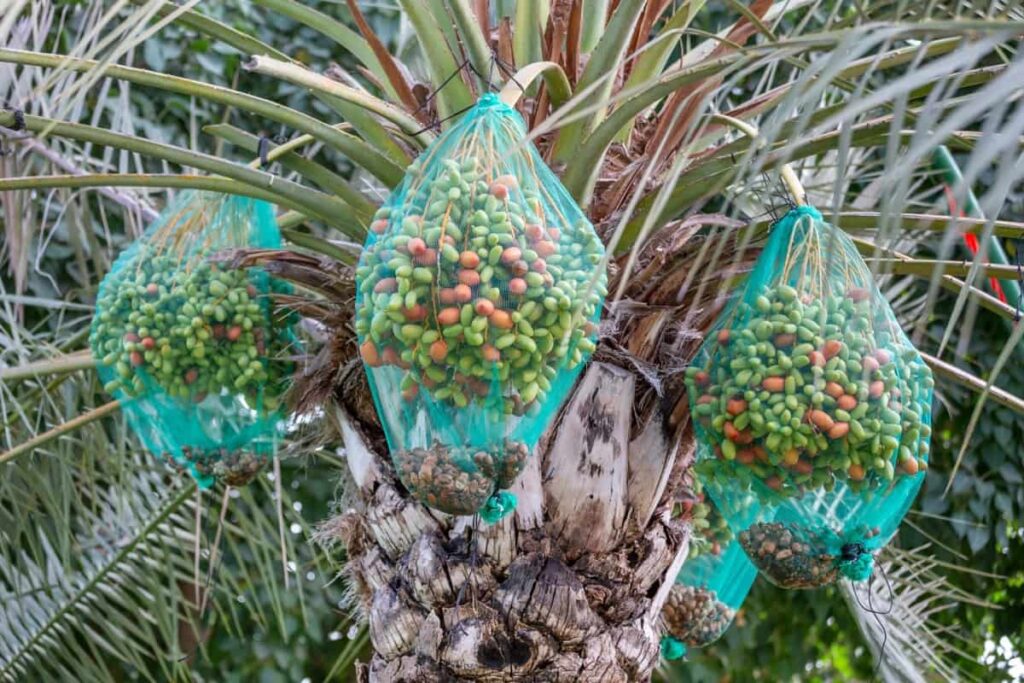
Harvesting and Yield of Date Palm
According to them, several farmers opted for date farming in Karnataka, and harvesting is the easiest stage. Dates begin producing fruit in the third or fourth year. Depending on the date, the tree may begin bearing fruit as early as the sixth year. Then, depending on the market, fruit can be harvested. If the fruits are immature, some will pick them before they ripened, while others will wait until they’ve matured completely.
Harvesting fruits that are much beyond their prime for dried and wrinkled fruits is possible for some. A tree’s fruit production can range from 100 to 125 kg when grown optimally and using optimum agricultural methods. Even though date trees take a few years to give fruit, they will continue for 50 to 70 years. This is how dates are harvested and processed.
Profit in Dates Cultivation in Karnataka
Date farming profit in India is quite huge. Date palm harvesting begins in June and lasts until September 15 each year. A farmer might expect to make between 2.5 and 4 lakhs in profit from cultivating a single acre at a market price of 1000 per kg.
Conclusion
Proper business plan and good cultivation practices, there is a huge profit in Date Palm Cultivation in Karnataka. If you live in the following districts of Karnataka and planning to start a commercial Date Palm Cultivation, this blog post will help you with the basics.
In case you missed it: Sikkim Organic Farming: For Vegetables, Herbs, Fruits, Millets, Crops, Livestock, and Aquaculture
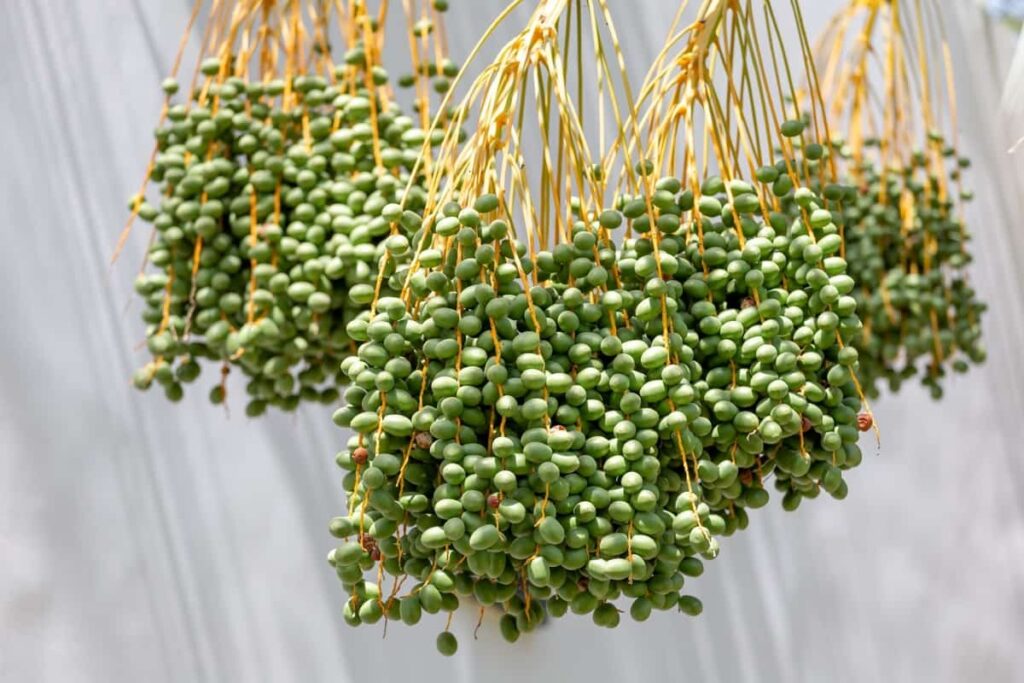
| Bagalkot | Haveri |
| Ballari | kalaburagi |
| Bangalore Rural | Kodagu |
| Belagavi | Kolar |
| Bengaluru | Koppal |
| Bidar | Mandya |
| Chamarajanagar | Mysuru |
| Chikballapur | Raichur |
| Chikkamagaluru | Ramanagara |
| Chitradurga | Shivamogga |
| Dakshina Kannada | Tumakuru |
| Davanagere | Udupi |
| Dharwad | Uttara Kannada |
| Gadag | Vijayapura |
| Hassan | Yadgir |
- How to Raise Pigs in Your Own Backyard: A Comprehensive Guide
- Budget Friendly Sheep Shed Ideas: Cheap and Low-Cost Tips
- How Much Do Cattle Farmers Make: Revenue Streams in Cattle Farming
- Management Pests and Diseases in Your Cotton Field
- Sheep Farming Business Plan for Beginners
- Aquaponic Farming at Home: A Step-By-Step Guide
- Profitable Village Farming Business Ideas in 2024
- High-Yield Aquaculture: Fast-Growing Fish for Farming
- Effective Fish Pond Construction Techniques for Beginners
- Irrigation and Water Management in Pineapple Farming
- Blossom to Harvest: Mastering Flowering and Pollination in Papaya Farming
- Pig Fattening Essentials: From Selection to Sale for Beginners
- Raising Wagyu Cattle: A Complete Guide for Premium Beef Production
- Soil Types and Their Water Holding Capacity
- Optimizing Irrigation Schedules for Coconut Groves for Enhanced Yield
- Espresso Your Garden: Coffee Grounds for Healthier Acid-Loving Plants
- The Best Soil Mix for Snake Plants: How to Mix Your Own Snake Plant Soil
- Green Thumb Success: Expert Tips for Cultivating Greenhouse Beans All Year Round
- Bloom All Year Round: The Ultimate Guide to Indoor Hyacinth Care
- Eco-Friendly Gardening: How to Make Liquid Fertilizer from Kitchen Waste
- Ultimate Guide to Grow Anise in Pots: Explore Seed Propagation to Harvesting
- Guide to Raising Chester White Pigs: Discover Breed Facts to Growth Management
- Mastering the Elegance: The Ultimate Guide to Weeping Cherry Tree Care, Planting, and Maintenance
- Ultimate Guide to Planting Garlic in Grow Bags: Growing Strategies for Beginners
- How to Fix Spider Plant Leaf-Related Problems: Natural and Organic Remedies
- 10 Reasons Why Your Tulsi Plant is Shedding Leaves: Home Remedies and Solutions
- Optimizing Growth and Yield: The Advantages of Palm Bunch Ash Fertilizer
- Utilizing Neem Oil Extract as a Natural Pesticide for Hydrangea
- From Soil to Harvest: Various Ways in Which Farmers Can Use AI Tools
- Steps to Encourage and Induce Citrus Flowers: A Comprehensive Guide
- How to Fix Snake Plant Leaf-Related Issues: Natural and Organic Remedies
- Transform Your Garden into a Fragrant Oasis with Raat Ki Rani (Night Blooming Jasmine)
- Discover the Ideal Chicken Breeds for Philippine Farms
- How to Create a Poultry Egg Farm Business Plan for Profits
- Grow Lemon Cucumbers Like a Pro: Insider Techniques for Bountiful Yields
- Ultimate Guide to Caring for Your Pink Princess Philodendron: Tips for Thriving Variegation
